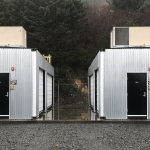The Energy Management System (EMS) is the project’s operating system, it is the software that is responsible for controls (charging and discharging), optimization (revenue and health) and safety (electrical and fire). The EMS coordinates the inverters, BMS, breakers and fire system. But what happens when it does not work well?
There is a trend in the industry to upgrade or retrofit the EMS because of economic and operational issues. Retrofitting the EMS is a big decision, and it is important to plan out the retrofit sequence properly. “About 20% of our deal flow is retrofits,” said Daniel Crotzer, CEO of Fractal EMS.
BMS vs EMS: What is the Difference?
The battery management system (BMS) is often confused with the EMS. The BMS is a simple system that does two things: 1) place the batteries online/offline 2) keep the batteries safe. When starting a BESS, the EMS will request that the BMS place the batteries online (establish the DC bus). If the BMS senses it is safe, then it will carry out the command. While operating, if the BMS senses parameters that are out of range, then it will request that the EMS reduce power (if parameters are violating fault thresholds, then the BMS will open rack contactors).
Compared to solar SCADA, BESS EMS is significantly more difficult. Some owners have found this out the hard way. The EMS has an outsized responsibility compared to its cost. For projects larger than 100 MWh, the following are two cost metrics:
- CAPEX: the EMS should cost less than 1% of project CAPEX for the following scope:
- Control equipment and control code
- RTACs and programming
- Cybersecurity equipment and configuration
- Networking equipment and setup
- HMI/historian server and software (including reports)
- OPEX: the EMS annual software license should cost less than 1% of annual revenue (revenue optimization should also cost less than 1% of revenue)
Reasons for Retrofits
- The EMS is underperforming or not working:
- Stratified SOCs across battery containers
- Inability to read and/or diagnose equipment fault codes
- Inability to remotely clear equipment fault codes
- Inability to overcome OEM local controller issues (if applicable)
- Inability to compensate for BMS deficiencies (P-limiting, SOC thresholds, fire alarm issues, etc.)
- The integrator has maxed out their liquidated damages (and have probably reduced support)
- Inability to meet ancillary qualification requirements e.g., Fast Frequency Response
- Poor DC coupled PV + storage performance
- Cybersecurity concerns
- Failure to meet recommendations of NERC CIP, NIST 800 and ISO 27001
- Need for on-site controls and servers (i.e., no cloud commands)
- CIFIUS requirements (especially if computer boards and code are foreign)
- Cyber risk due to a foreign BMS
- EMS is outsourcing or off-shoring software development
- Lackluster HMI/UI experience, historian, analytics or reporting
- Lack of fire system integration (some EMS provide similar functionality to a FACP)
- BESS EMS does not properly integrate with the owner SCADA or EMS
- Poor customer service or outsourced technical support to foreign country
- Universal fleet control: as the owner accumulates multiple projects, they realize a universal EMS system is preferred
- The EMS company is insolvent or no longer supports the EMS
- The EMS is expensive relative to its features
Process and Timeline to Retrofit
The following is a high level summary of the steps and timeline to perform a retrofit.
- Research the existing project (1-2 weeks):
- Equipment and network topography
- Project documentation
- Deep dive existing issues
- Project scope and desired control modes
- Provide a 60% drawing set of the new EMS (2-3 weeks)
- EMS equipment procurement and shipment (4-12 weeks)
- Removal of old EMS equipment (1-2 days)
- Installation of Fractal EMS equipment (2-3 days)
- Fractal EMS integration, development, and testing (4 weeks)
- Commissioning and Substantial Completion (2 weeks)
The decision to retrofit the EMS often comes down to the following themes:
- The EMS subscription is expensive (more than 1% of annual revenue).
- The EMS is causing downtime (EMS availability of less than 99% is detrimental).
- The EMS has cybersecurity concerns or is not addressing foreign equipment risks (e.g., cyber attack through the BMS).
- The EMS allows the owner to consolidate software for their operations team while keeping the ability to choose different equipment project to project.
Read More







